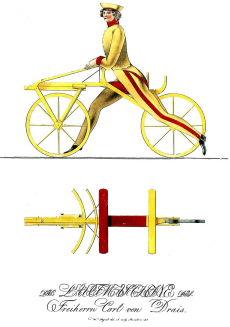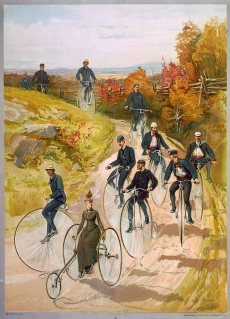
The first ‘bicycle’ was the German velocipede or dandy horse, which was invented in 1817 (pictured). It barely resembled modern bicycles, but was the first means of transport to use two wheels in-line with each other, and so can be seen as a precursor. The inventor, Baron Karl Drais, supposed sought an alternative to the horse due to the animals’ mass starvation and death during a crop failure the previous year. He also called his machine a Laufmaschine which translates as ‘running machine’, as the rider propelled themselves along by pushing along the ground with their feet. Like modern bicycles it had a set of handlebars attached to the front wheel to allow the user to steer it. The dandy horse was popular throughout Europe during the summer of 1819, but unfortunately many accidents with pedestrians led to a ban in many cities.
The first mechanically propelled bicycle may have been invented as early as 1839, by a Scottish blacksmith named Kirkpatrick MacMillan, and was also the cause of at least one accident. In 1842 a Glasgow newspaper reported that an anonymous "gentleman from Dumfries-shire... bestride a velocipede... of ingenious design" knocked over a pedestrian in the Gorbals and was fined five British shillings. The first documented mechanical bicycle was the treadle bicycle invented by another Scot, Thomas McCall. The treadle bike used an alternative mechanism to modern bicycles, as no bike chains were available. Instead it had a treadle: a set of rods connected to the back wheel.
The first ‘true’, pedal-powered bicycle was invented in France during the 1860s, and first manufactured by Pierre Michaux from 1867 to 1869. Pedalling was much faster than the earlier foot or treadle-powered mechanisms, while the introduction of metal rather than wooden frames made these bikes much lighter and sleeker. However, the wrought-irons frames were still very stiff, and together with the wooden wheels made for a very uncomfortable ride, earning it the nickname of ‘bone-shaker’.

The late 1860s saw the invention of the iconic penny-farthing (pictured), first patented by Eugène Meyer of Paris. Its name derives from the two differently sized British coins which its wheels resembled, though this name was only given once it was already going out of fashion. At the time it was simply known as a “bicycle”—the first invention to earn the name. The larger wheels allowed for higher speeds and a smoother ride, while the introduction of rubber tires and hollow frames made the penny farthing much lighter. There was, however, the very real risk of being pitched forwards over the handlebars; ‘moustache’ handlebars were invented in response, allowing the rider to put their legs over the top and so land on their feet!
Safety bicycles replaced penny farthings from the late 1880s, and really made bicycles an everyday means of transport. The introduction of the chain drive meant the bike could have much smaller wheels, so the user was much closer to the ground and much safer as a result. The first commercially successful safety bike was made by John Kemp Starley, now considered the inventor of the modern bicycle as we know it. All bicycles used today use the same basic design as the safety bike.
Images: https://upload.wikimedia.org/wikipedia/commons/thumb/4/42/Draisine1817.jpg/800px-Draisine1817.jpg
https://upload.wikimedia.org/wikipedia/commons/thumb/4/44/Bicycling-ca1887-bigwheelers.jpg/800px-Bicycling-ca1887-bigwheelers.jpg

0 Comment:
Be the first one to comment on this article.